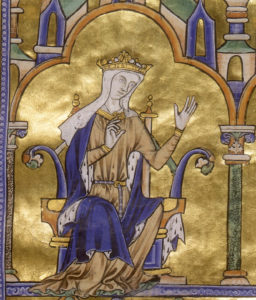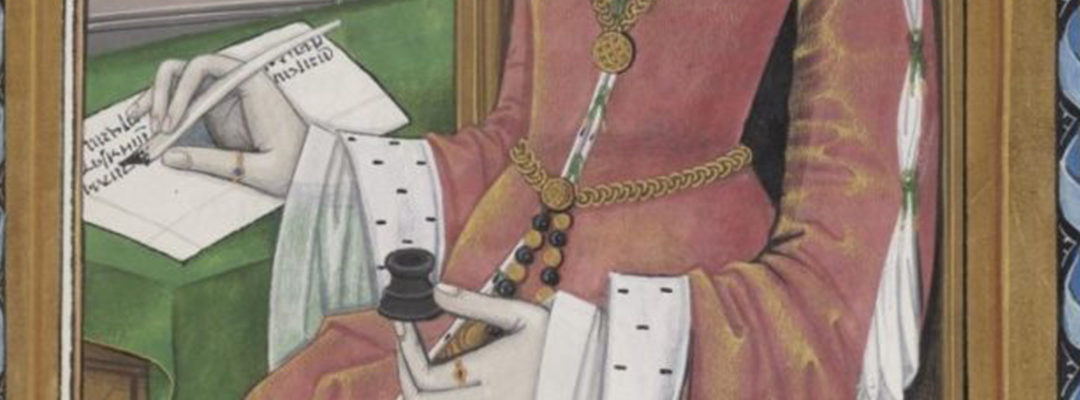By Anaïs Waag
Until very recently medieval studies was dominated by the perception that women were actively kept away from political power – a notion we owe mainly to nineteenth-century historians. While there was undoubtedly a preference for male rulers throughout the middle ages, there was generally even greater preference for dynastic continuity. Queens are ever present in chronicles and other contemporary writings, and a wide-range of documents were written in their names. Once historians began to actively look for queens within these sources, they are easily found.
Medieval queenship as an academic subject emerged in the 1970s, and since its inception the participation and agency of queens has been extensively explored and demonstrated. Over the last fifty years, particularly in the last thirty, the study of queenship has begun to reveal the cluster of customs, practices and political theory that comprised the role of the medieval queen. Initially, scholarship focused on the early medieval period, and identified a framework of female power which revolved around the household: the household was at the centre of early medieval government, and women were at the centre of the household. Early medieval queens often co-issued charters with their husbands, and even issued charters in their own name. In doing so they demonstrated participation in the direct and public exercise of power.

Because later queens did not appear as extensively within charters, this earlier scholarship identified the eleventh century as a watershed for women’s political participation and the ensuing centuries as marked by the loss of political power and legitimate authority for the queen. It was soon demonstrated, however, that while the development of royal bureaucracies in the eleventh and twelfth centuries did indeed shrink the queen’s area of responsibility, and limited her public and direct participation in her husband’s government, this did not translate to her complete exclusion from public life. Instead, a distinct framework of power was identified, one which revolved around the lasting image of the ideal queen. By emphasising the queen’s role as peacemaker, nurse, benefactress and, most importantly, mother and intercessor, this image sought to restrict her area of influence. It did, however, emphasise her personal and particular relationship with the king, and how the queen was distinguished, like her husband, from the kingdom’s subjects.
In seeking to examine and demonstrate the queen’s participation and agency, queenship studies has also, in the words of Theresa Earenfight, provided a new framework for the study of power, and led to a reconsideration of medieval monarchy. To understand power solely within the context of law and force, and within the context of direct and public exercise of power, is too narrow. Rather than understand medieval monarchy simply as the rule of one – the king – it should instead be understood as an institution that centred on the family. Broadening the conventional understanding of power allows us not only to better comprehend both the power dynamics of monarchy, but also the medieval queen’s relationship with and participation in power. Nonetheless, there is still much to understand regarding how late medieval female power was expressed.

Making use of the historical ‘auxiliary science’ of diplomatics to analyse a corpus of both female and male royal letters, my current research explores how far a gendered register of power and authority structured these letters, and particularly how gender was expressed through their clauses and formulae. Perhaps surprisingly, I have found that male and female power and authority were not expressed all that differently: women and men made use of a shared epistolary discourse, and this shared discourse engaged with, transgressed and manipulated the rules of the ars dictaminis (the conventions which governed public letter writing).
It is regularly assumed that most medieval letters strictly adhered to the prescribed rules and norms of the ars dictaminis. This is not quite the case. The ars dictaminis was a fundamental tool for communication, but one within which the prescribed rules and norms were regularly transgressed and manipulated, and which used these transgressions and manipulations to enable further communication between the letter’s sender and its receiver.
My research focuses on how the formal structures of letter writing were manipulated and used – both successfully and unsuccessfully – by thirteenth-century political actors. So far, it would seem that these transgressions were deliberate, and served multiple purposes, some personal and others overtly political. That both women and men were committing these transgressions substantiates the use of a shared epistolary discourse, and suggests a degree of shared gender participation within it. And yet, this shared use of epistolary discourse does not mean that women and men did not continue to make use of gendered language within their letters – indeed, gendered language was similarly used as a tool for communication. These are important points for understanding how late medieval female power was expressed. The ars dictaminis was used both strategically and systematically. Letter writing was an important and extensively used part of diplomacy, and women were accepted as key political players within this.
In applying diplomatics to royal letters – an overlooked source often considered less technical and juridical than legal documents, but also overly technical, juridical and impersonal when compared to later medieval and early modern letters –a new political language emerges, characterised by a discourse shared between women and men. The letter is a key source for revealing public political language and, as such, not only demonstrates the practice of queenship but also its formal expression, operating on the same stage as its male counterpart. It thus offers a new perspective on medieval queenship, its practice and expression.
 Anaïs Waag is a postgraduate at King’s College London and a Scouloudi Fellow at the IHR. Her paper Gender and the language of politics in thirteenth-century royal letters was runner up for the 2018 Pollard Prize and will be published in Historical Research.
Anaïs Waag is a postgraduate at King’s College London and a Scouloudi Fellow at the IHR. Her paper Gender and the language of politics in thirteenth-century royal letters was runner up for the 2018 Pollard Prize and will be published in Historical Research.

